An Experimental Study of Industrial Site and Shaft Pillar Mining at Jinggezhuang Coal Mine
Abstract
:1. Introduction and Geological Conditions
1.1. Introduction
1.2. Geological and Mining Conditions
2. Probability Integral Method Based on Stochastic Model
3. Mining Experiment of Panel 0091 and Subsidence Monitoring
3.1. Introduction
3.2. Measured Subsidence
- (1)
- Subsidence boundary angle: As defined in the regulation [19], the subsidence of point C6 is 10 mm and this can be considered as the subsidence boundary. The distance between C6 and the panel boundary is 274 m. The mine depth is 318 m. The subsidence boundary angle of the rise face is 49°.
- (2)
- Maximum subsidence angle: B10 represents the maximum measured subsidence. The distance between B10 and the panel center is 33.7 m and the mine depth of the center is 333 m. Thus, the maximum subsidence angle is 84°.
- (3)
- Advance angle: According to the data of B9, the inital influenced distance is 189 m. Thus, the advance angle is 61°.
- (4)
- The subsidence of B10 is used to study the dynamic subsidence laws. As shown in Figure 6, the maximum subsidence velocity is 1059 mm/month. The velocity is more than 50 mm/month for 124 days.
4. Pim Parameter Back Analysis Based on Line B Data
4.1. Ga Method of PIM Parameter Back Analysis
4.2. Results
5. New Shaft Pillar and Panel Design
6. Prediction of Ground Movement
6.1. Displacement of the Ground
6.2. Subsidence and Deformation of Surface Buildings
7. Discussion
- 1.
- The most important aspect is that excavation should not be carried out before a shaft is closed. In addition, mechanical analysis may be required in a few cases.
- 2.
- Mine subsidence should be predicted to determine the influence of surface subsidence on engineering facilities and buildings.
- 3.
- For deformation sensitive facilities, deformation monitoring and warning are the best methods of preventing loss of life and economic damage. This study used the PIM for predicting mine subsidence. The parameters obtained from the field-measured data were reliable and robust. However, as it is based on the discrete medium theory, it is difficult to calculate the stress and strain inside the rock. Therefore, if shafts are influenced by pillar mining, further analysis based on mechanical simulation is necessary. The major challenge is to balance economic benefits and safety.
8. Conclusions
- (1)
- First, a mine experiment with a deformation monitor is required. The mining subsidence geometry characteristics and prediction parameters can be obtained from experimental data analysis.
- (2)
- A new pillar should be designed on the basis of the parameters of the research area. The pillar should ensure that the safety of shafts are maintained until they are closed.
- (3)
- Deformation should be predicted and analyzed to ensure the safety of buildings and facilities at the engineering site.
Author Contributions
Funding
Institutional Review Board Statement
Informed Consent Statement
Data Availability Statement
Acknowledgments
Conflicts of Interest
Abbreviations
| FEM | Finite Element Method |
| FLAC3D | Fast lagrangian analysis of continua of three dimensional |
| PIM | Probability of integral method |
| JGZ | Jinggezhuang Coal Mine |
| GA | Genetic Algorithm |
| CIB | Coal Industry Bureau of China |
Appendix A
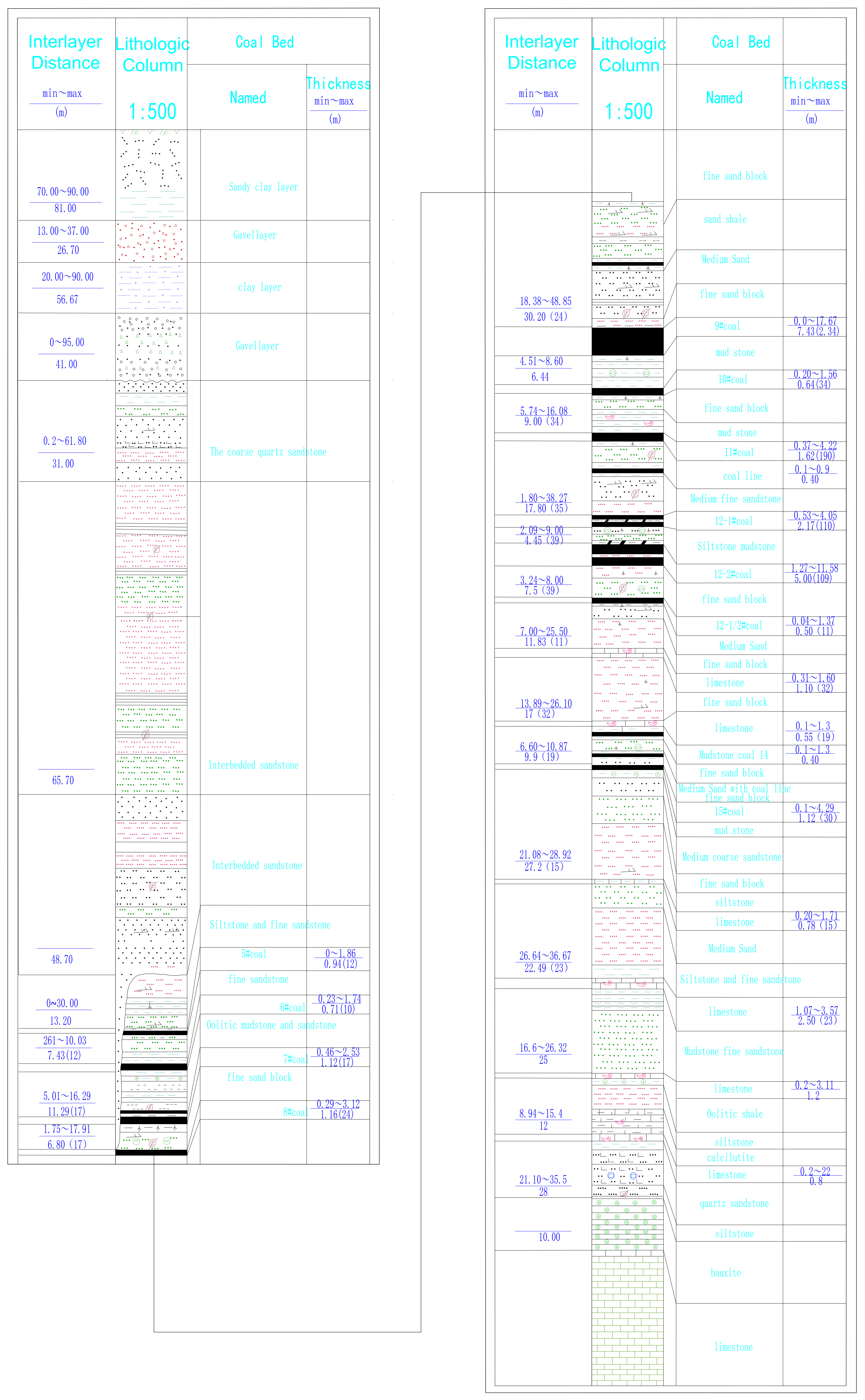
References
- Liu, B.; Liao, G. Basic Regulars of Coal Mine Subsidence; China Industry Press: Beijing, China, 1965. [Google Scholar]
- Yoshiaki, F.; Yoji, I.; Tatsuhiko, G. A Study on Shaft Damages due to Mining. Shigen-to-Sozai 1995, 111, 993–1000. [Google Scholar] [CrossRef]
- Johnson, J.; Poad, M. Premining stability analysis of a shaft pillar at the Homestake Mine. In Proceedings of the 30th US Symposium on Rock Mechanics, Morgantown, WV, USA, 19–22 June 1989; pp. 175–182. [Google Scholar]
- Helmuth, K. Mine Subsidence Engineering; Springer: New York, NY, USA, 1983. [Google Scholar]
- Sroka, A.; Knothe, S.; Tajduś, K.; Rafal, M. Underground exploitations inside safety pillar shafts when considering the effective use of a coal deposit. Gospod. Surowcami Miner. 2015, 31, 93–110. [Google Scholar] [CrossRef]
- Yu, Q.; Ma, J.; Shimada, H.; Sasaoka, T. Influence of Coal Extraction Operation on Shaft Lining Stability in Eastern Chinese Coal Mines. Geotech. Geol. Eng. 2014, 32, 821–827. [Google Scholar] [CrossRef]
- Jia, Y.D.; Stace, R.; Williams, A. Numerical modelling of shaft lining stability at deep mine. Min. Technol. 2013, 122, 8–19. [Google Scholar] [CrossRef]
- Johnson, J.C.; Orr, S.A. Rock mechanics applied to shaft pillar mining. Int. J. Min. Geol. Eng. 1990, 8, 385–392. [Google Scholar] [CrossRef]
- Bosman, J.D.; Van Aswegen, G. Dynamic Failure of Pillar Remnants—Case Studies. In Proceedings of the ISRM 2003-Technology Roadmap for Rock Mechanics. International Society for Rock Mechanics and Rock Engineering, South African Institute of Mining and Metallurgy, Sandton, South Africa, 8–12 September 2003; pp. 143–150. [Google Scholar]
- Pariseau, W. Design Analysis in Rock Mechanics; Balkema-proceedings and monographs in engineering, water and earth sciences; Taylor & Francis: London, UK, 2006. [Google Scholar]
- Akcin, H.; Kutoglu, H.S.; Kemaldere, H.; Deguchi, T.; Koksal, E. Monitoring subsidence effects in the urban area of Zonguldak Hardcoal Basin of Turkey by InSAR-GIS integration. Nat. Hazards Earth Syst. Sci. 2010, 10, 1807–1814. [Google Scholar] [CrossRef]
- Hongdong, F.; Li, T.; Gao, Y.; Deng, K.; Wu, H. Characteristics inversion of underground goaf based on InSAR techniques and PIM. Int. J. Appl. Earth Obs. Geoinf. 2021, 103, 102526. [Google Scholar] [CrossRef]
- Na̧dudvari, A. Using radar interferometry and SBAS technique to detect surface subsidence relating to coal mining in Upper Silesia from 1993 to 2000 and 2003–2010. Environ. Socio-Econ. Stud. 2016, 4, 24–34. [Google Scholar] [CrossRef]
- Terrone, M.; Piana, P.; Paliaga, G.; D’Orazi, M.; Faccini, F. Coupling Historical Maps and LiDAR Data to Identify Man-Made Landforms in Urban Areas. ISPRS Int. J. Geo-Inf. 2021, 10, 349. [Google Scholar] [CrossRef]
- Fang, X.; Zhang, F.; Shi, Z.; Liang, M.; Song, Y. Research and Application of Multi-Mode Joint Monitoring System for Shaft Wall Deformation. Sensors 2022, 22, 6551. [Google Scholar] [CrossRef] [PubMed]
- Zhao, H.; Ma, F.S.; Xu, J.M.; Zhang, Y.M.; Guo, J. Shaft deformation and failure due to rock mass movement induced by underground backfill mining of a metal mine. Chin. J. Geotech. Eng. 2012, 34, 340–348. [Google Scholar]
- Poad, M.; Pariseau, W.; Laurenti, M. Ross shaft pillar project at the Homestake mine. Int. J. Rock Mech. Min. Sci. Geomech. 1995, 47, 80–84. [Google Scholar]
- Litwiniszyn, J. Stochastic Methods in Mechanics of Granular Bodies; Springer: Vienna, Austria, 1974. [Google Scholar]
- Coal Industry Bureau of People’s Republic of China. Regulations of Buildings, Waterbody, Railway, Shaft and Tunnel Pillar Design and Its Mining; China Coal Industry Publishing House: Beijing, China, 2000. [Google Scholar]
- He, G.; Yang, L.; Ling, G.; Jia, F.; Hong, D. Mine Subsidence; China University of Mining and Technology Press: Xuzhou, China, 1991. [Google Scholar]
- Li, P.; Wan, H.; Xu, Y.; Yuan, X.; Zhao, Y. Parameter inversion of probability integration method using surface movement vector. Chin. J. Geotech. Eng. 2018, 40, 767–776. [Google Scholar] [CrossRef]
- Wang, G.; Wu, Q.; Li, P.; Cui, X.; Gong, Y.; Zhang, J.; Tang, W. Mining Subsidence Prediction Parameter Inversion by Combining GNSS and DInSAR Deformation Measurements. IEEE Access 2021, 9, 89043–89054. [Google Scholar] [CrossRef]
- The Energy Department of the People’s Republic of China. Mine Survey Regulations; China Coal Industry Publishing House: Beijing, China, 1989. [Google Scholar]
- Li, P.; Peng, D.; Tan, Z.; Deng, K. Study of probability integration method parameter inversion by the genetic algorithm. Int. J. Min. Sci. Technol. 2017, 27, 1073–1079. [Google Scholar] [CrossRef]
- Li, P. Study on Regularity and Prediction Method of Surface Subsidence Due to Deep Mining. Ph.D. Thesis, China University of Mining and Technology, Xuzhou, China, 2012. [Google Scholar]
- National Bureau of Statistics of China. Annual Statistics Report. 2019. Available online: http://www.stats.gov.cn/tjsj/tjgb/ndtjgb/ (accessed on 29 December 2019).
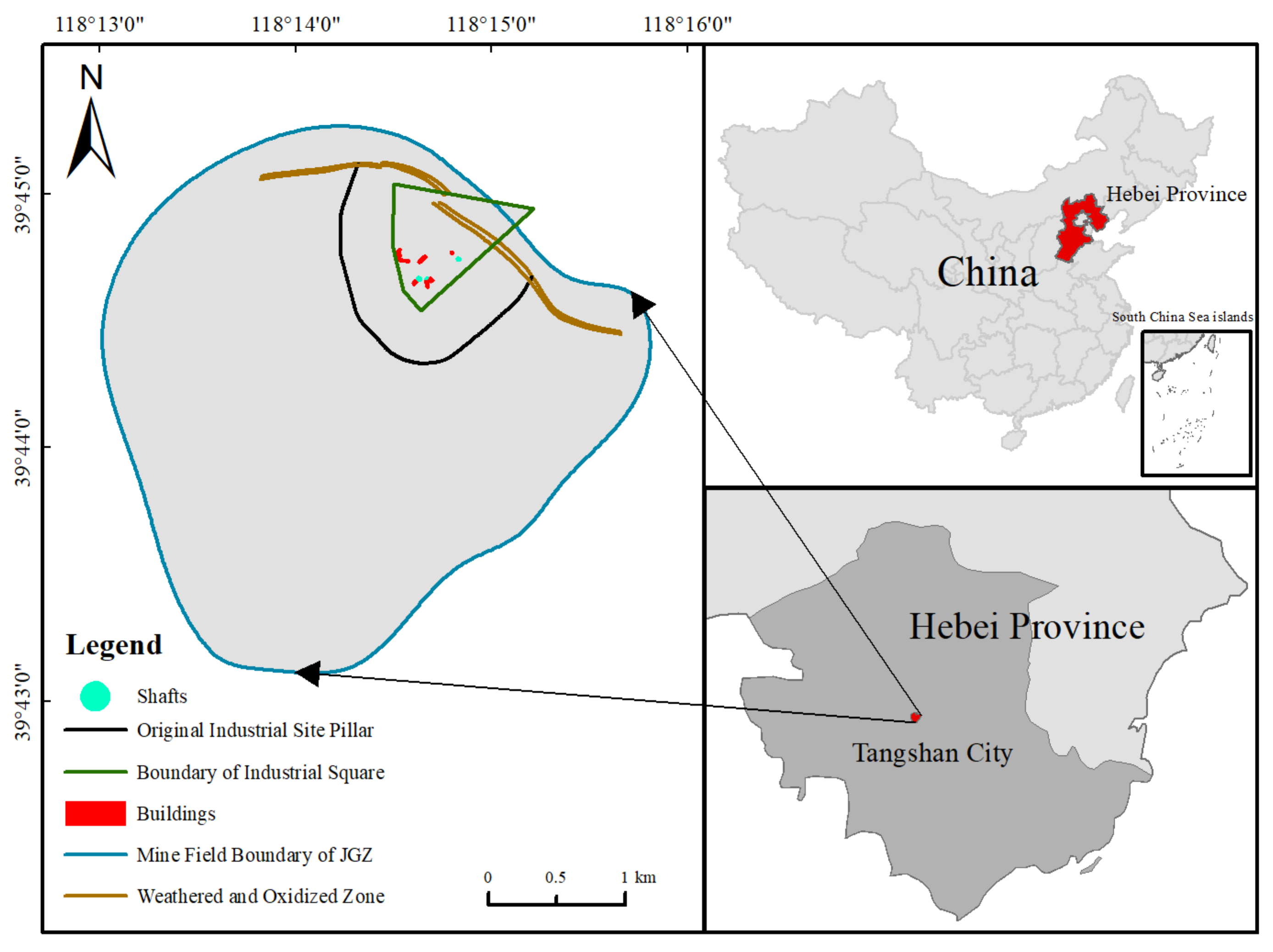
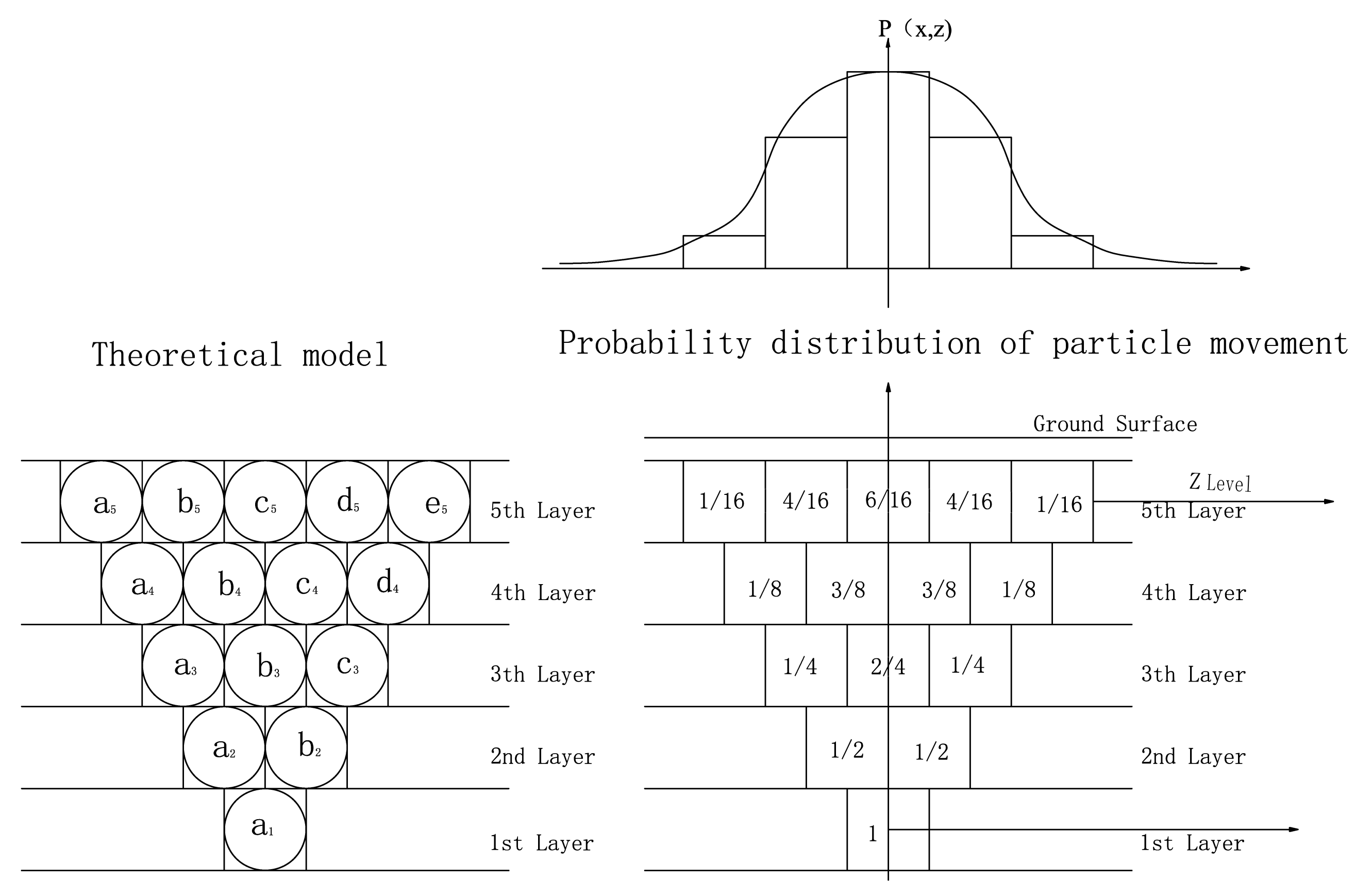
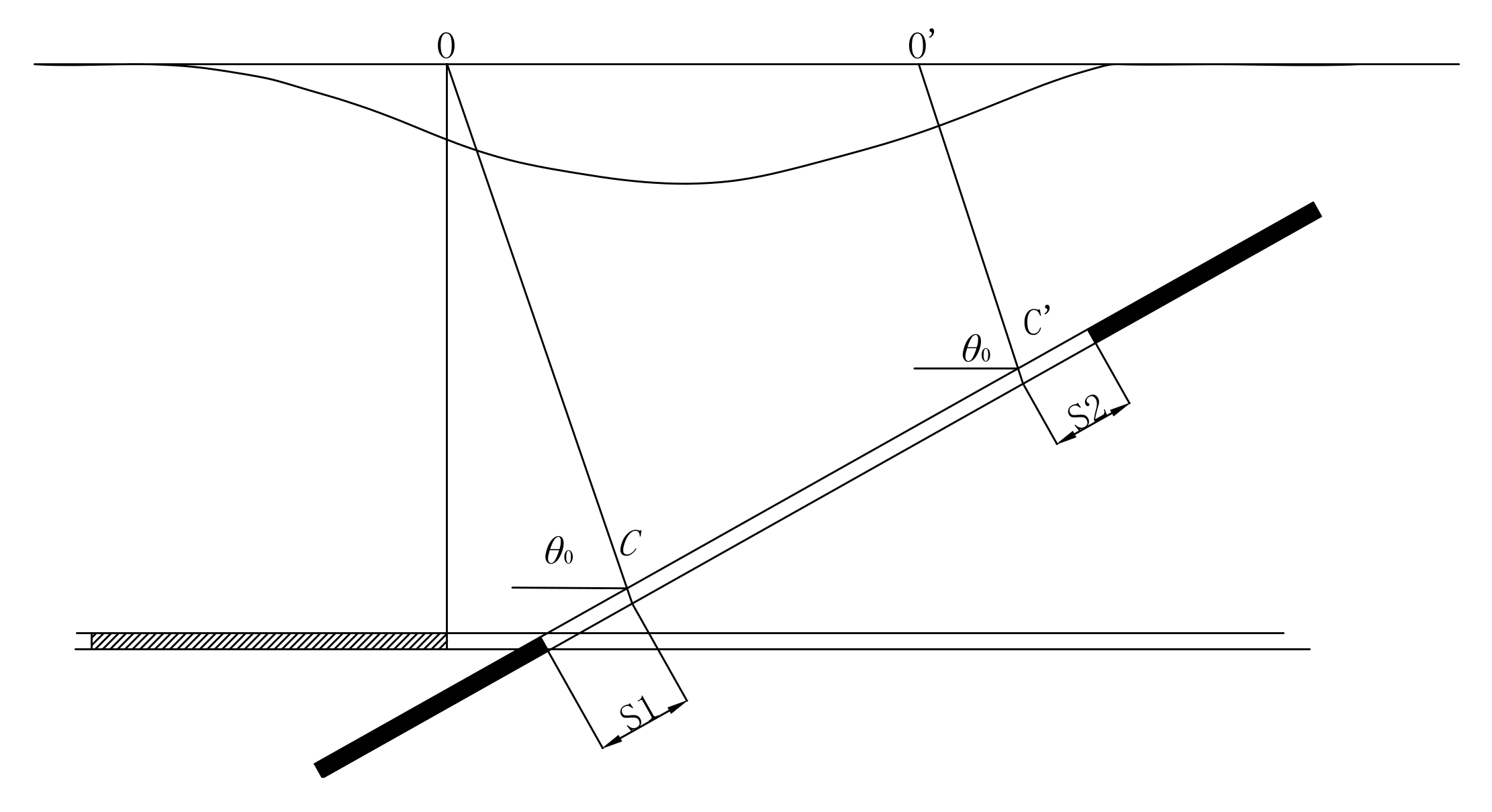
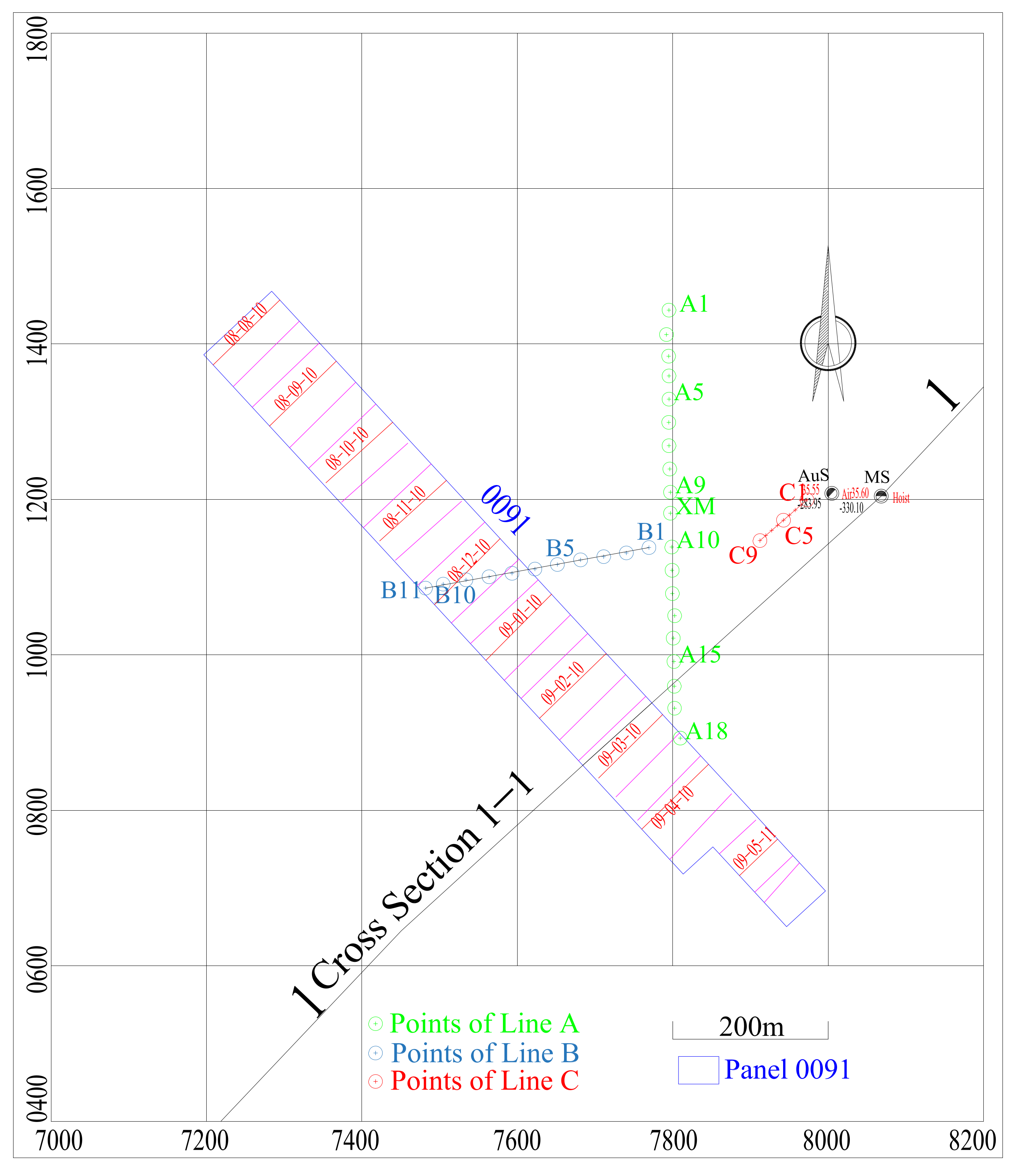
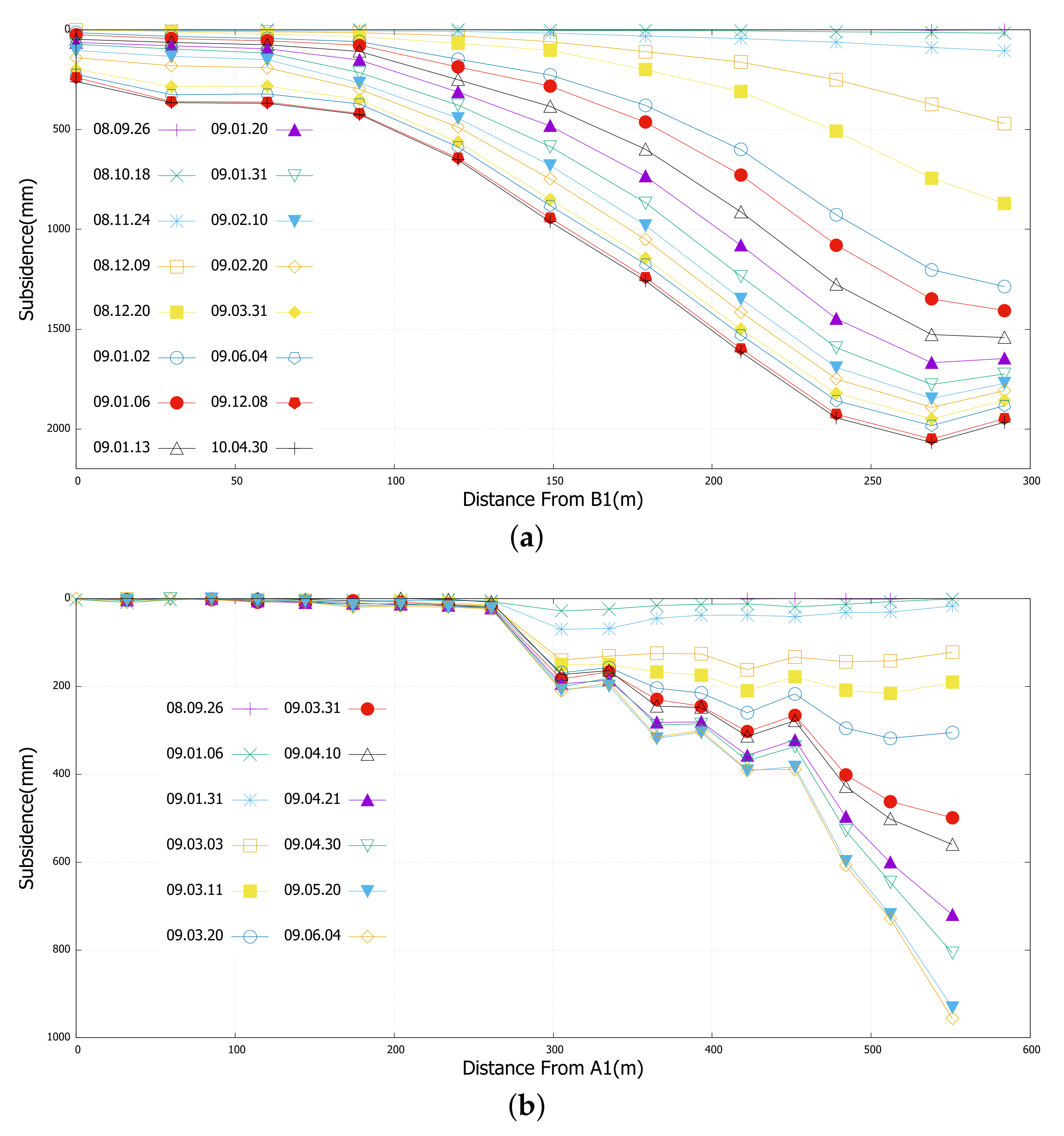
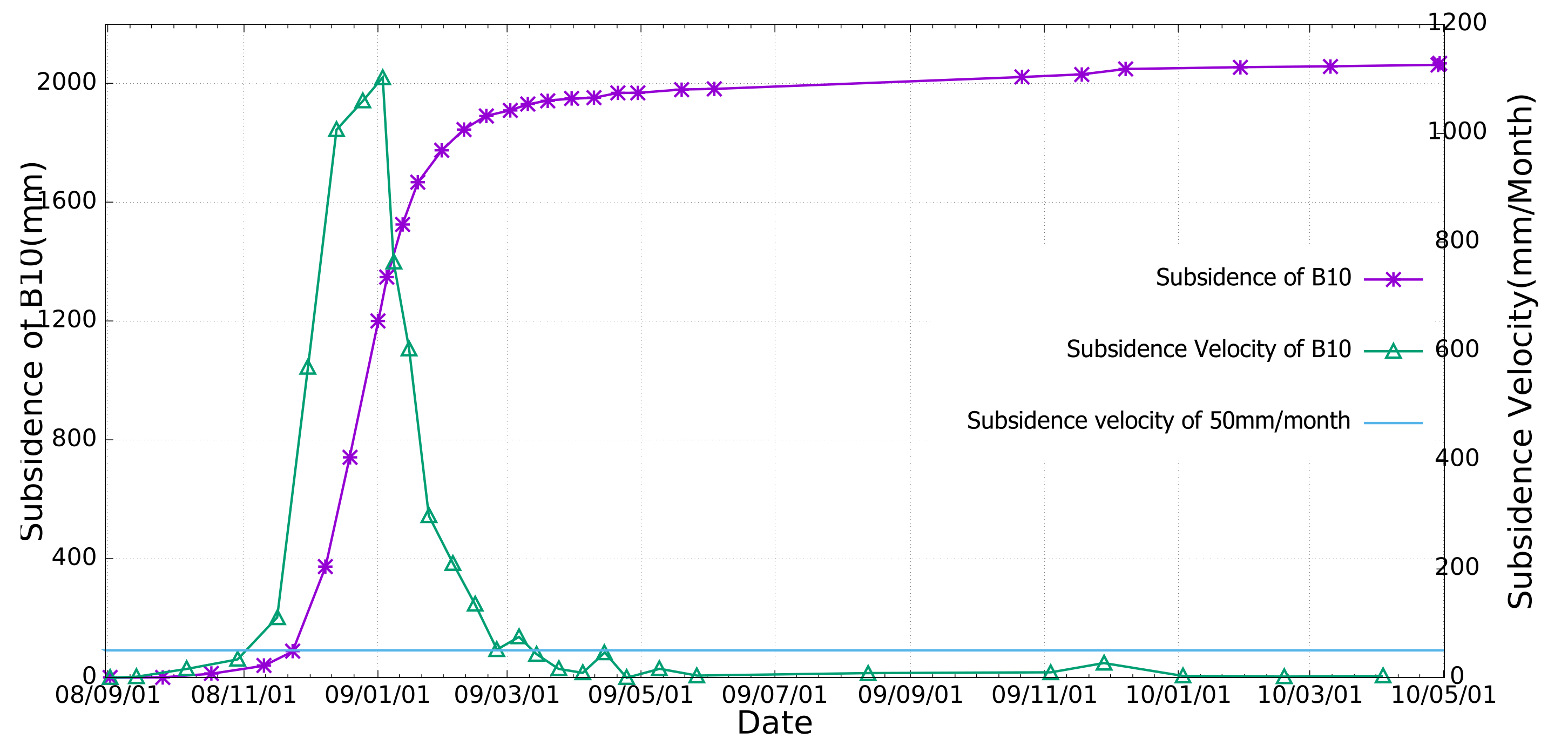
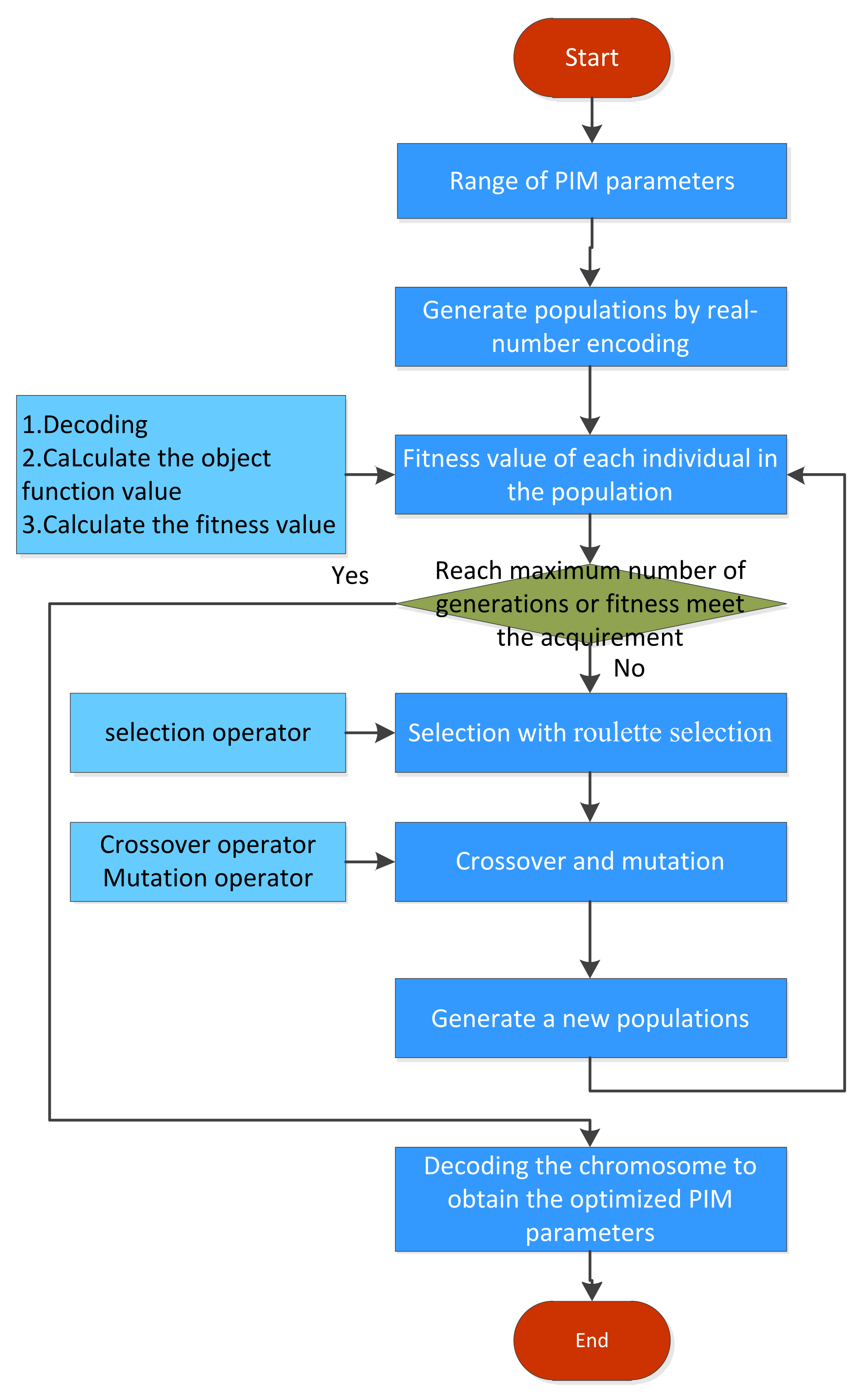
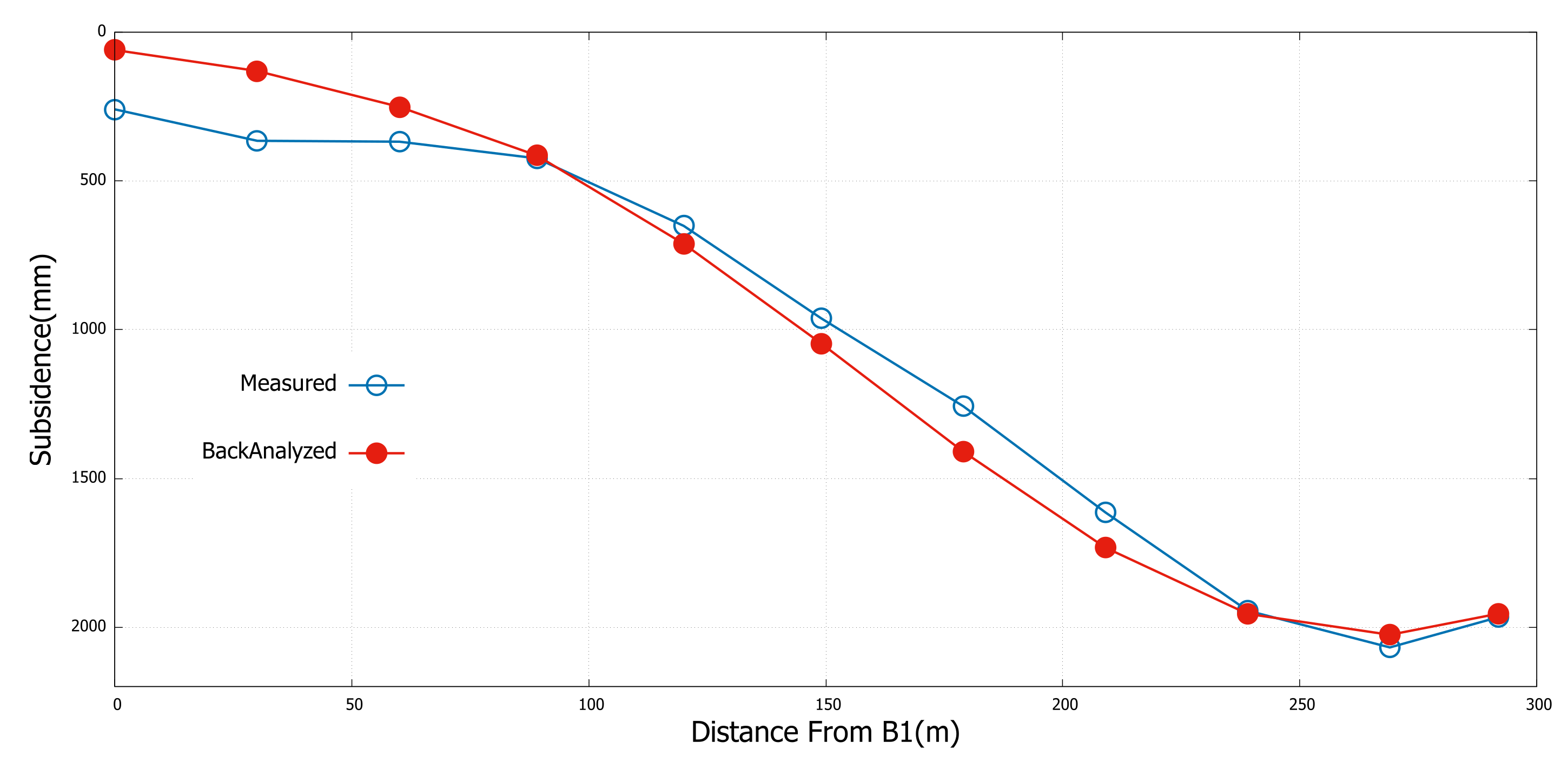
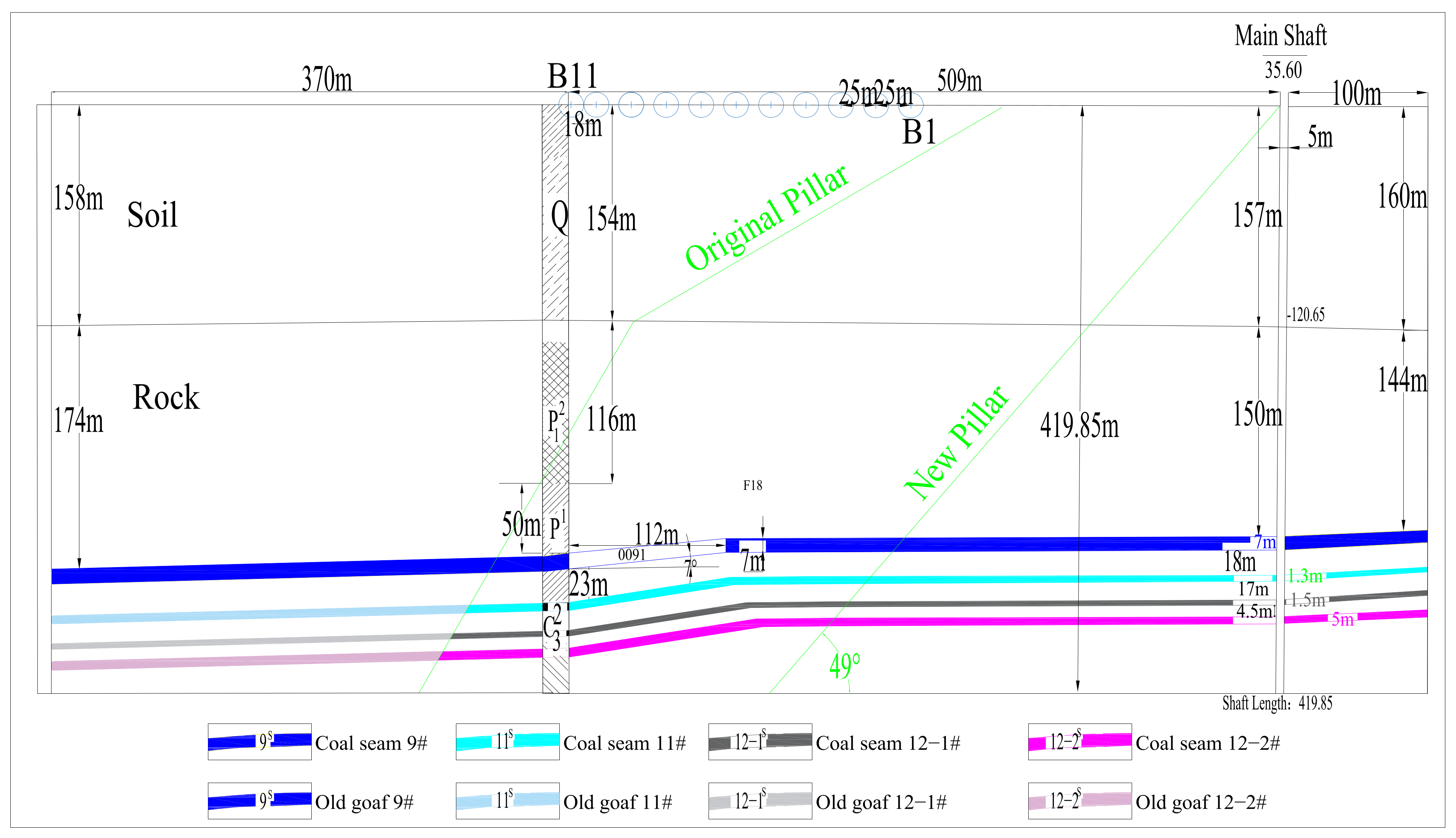
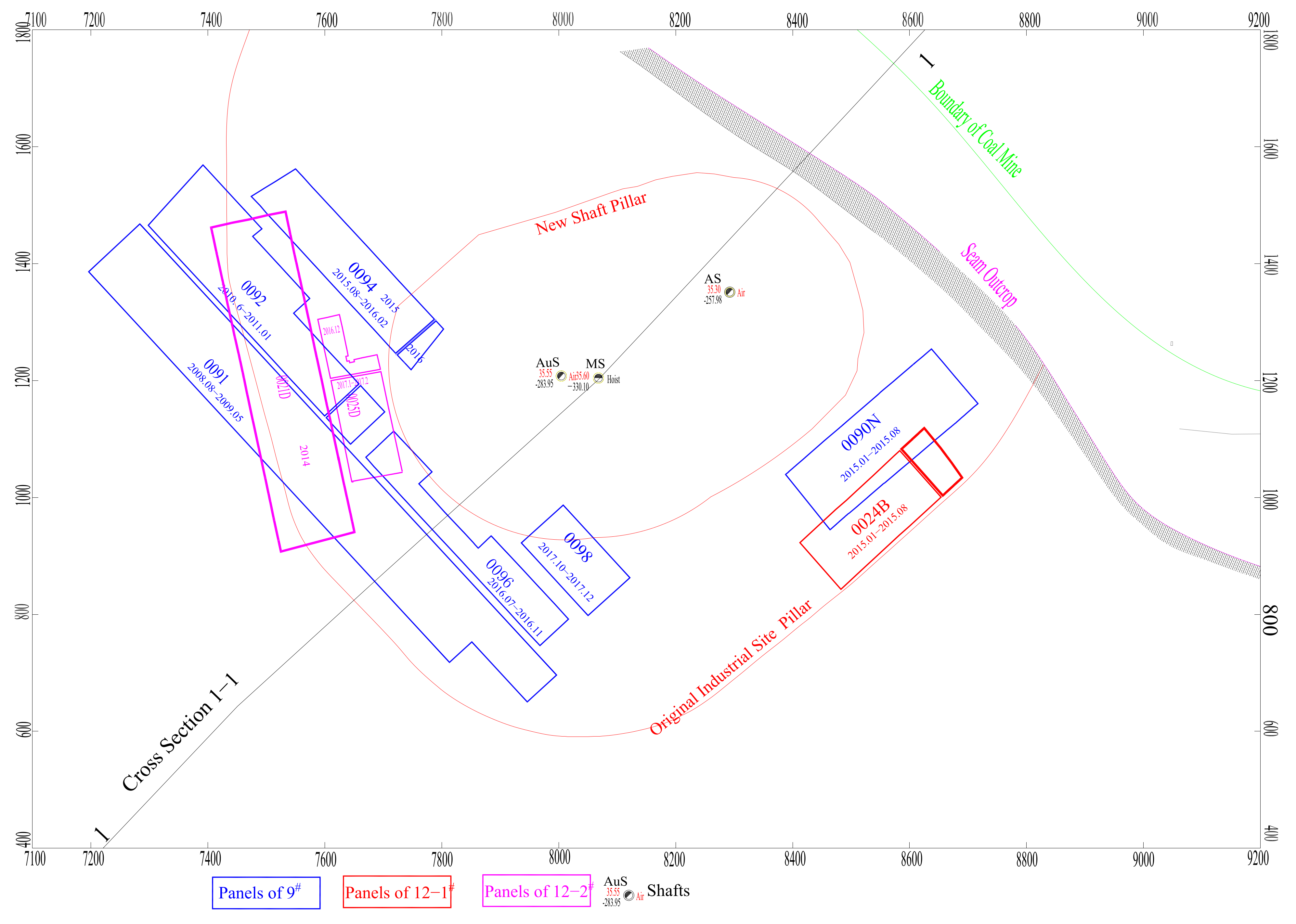

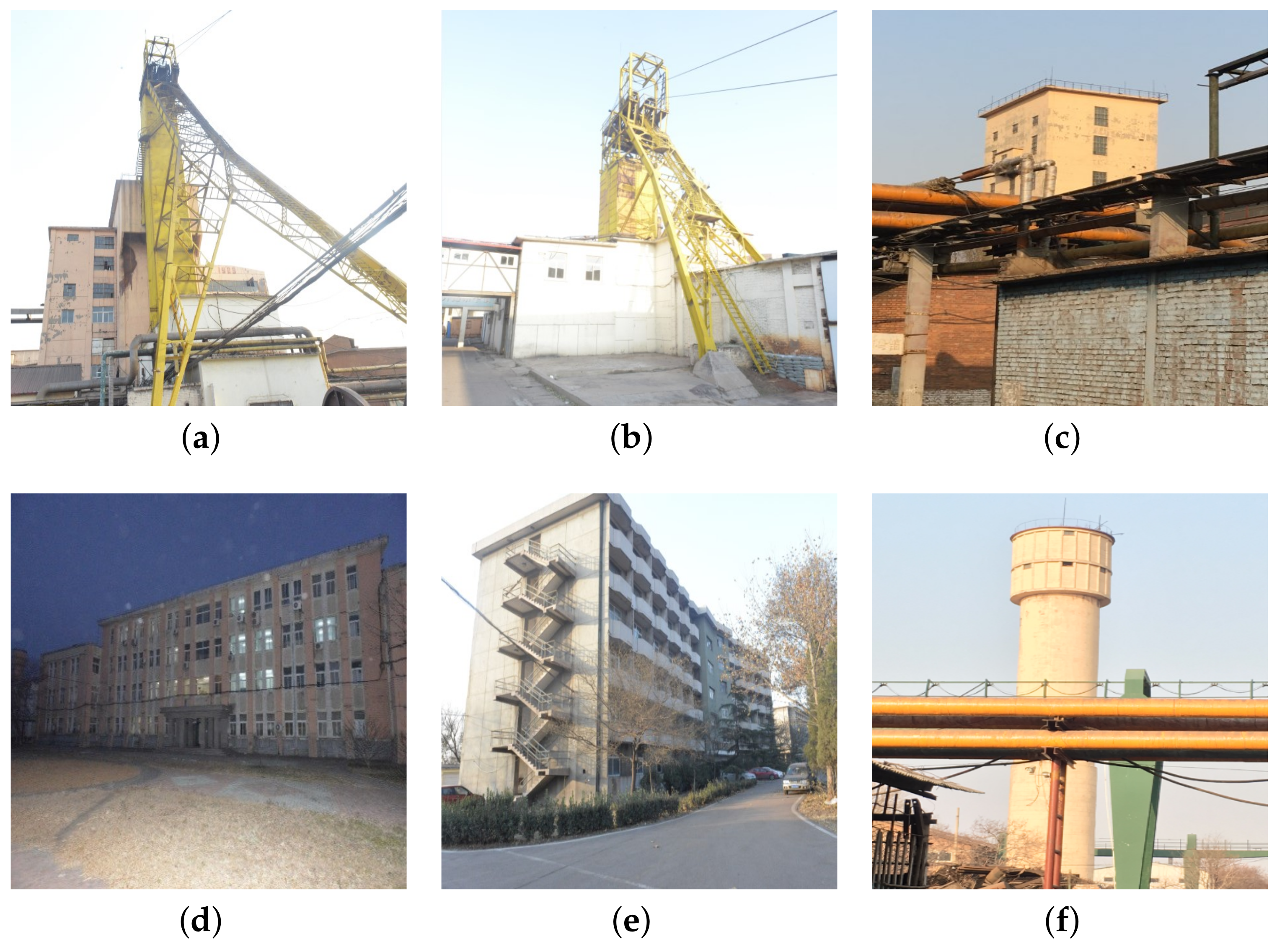
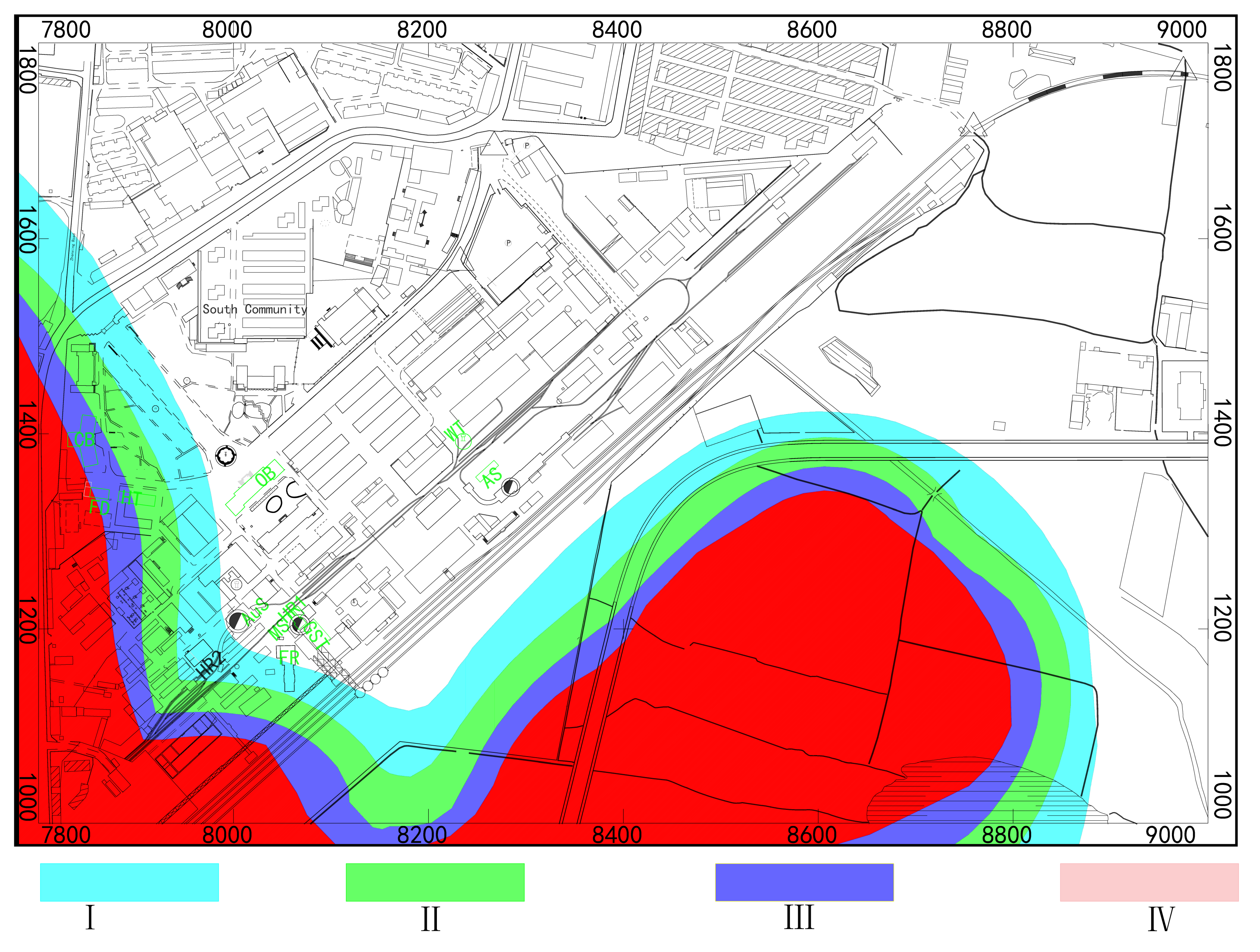
| Panel No. | Mine Time | Mine Depth (m) | Mine Thickness (m) | Dip Angle (°) | Production (t) |
|---|---|---|---|---|---|
| 0091 | 2008.08∼2009.05 | −290∼−321 | 6.8∼7.1 | 3∼12 | 1,177,039 |
| 0092 | 2010.06∼2011.05 | −282 ∼−321 | 6.8∼7.1 | 4∼ 8 | 643,910 |
| 0021D | 2014.01∼ 2014.12 | −334∼−339 | 4.75∼5.15 | 1∼9 | 610,488 |
| 0090N | 2015.01∼2015.08 | −228∼−297 | 3.5∼5 | 1∼19 | 281,536 |
| 0094 | 2015.08∼2016.01 | −276∼−301 | 4 | 2∼14 | 210,790 |
| 0024B | 2015.07∼2015.11 | −314∼−340 | 1.7∼2 | 1∼14 | 14,141 |
| 2016.05∼2016.07 | 69,118 | ||||
| 0096 | 2016.07∼2016.11 | −271∼−289 | 4.6∼4.8 | 1∼11 | 148,404 |
| 0025D | 2016.12∼2017.04 | −325∼−349 | 3.6∼3.8 | 3∼12 | 133,063 |
| 0098 | 2017.10∼2017.12 | −275∼−285 | 5.6∼7.0 | 0∼4 | 309,120 |
| W | i | K | U | ε |
|---|---|---|---|---|
| mm | mm/m | mm/m2 | mm | mm/m |
| 7419 | 40 | −0.465∼0.273 | 3620 | −32.196∼17.516 |
| Level | ε (mm/m) | Surface Deformation K (mm/m2) | i (mm/m) | Classification |
|---|---|---|---|---|
| I | ≤2 | ≤0.2 | ≤3 | Minor |
| II | ≤4 | ≤0.4 | ≤6 | Mild |
| III | ≤6 | ≤0.6 | ≤10 | Moderate |
| IV | >6 | >0.6 | >10 | Serious |
| Building | Subsidence (mm) | Tilt (mm/m) | Curvature (mm/m2) | Displacement (mm) | Strain (mm/m) | Damage Level |
|---|---|---|---|---|---|---|
| CB | 322 | 6.96 | −0.015∼0.111 | 473 | −1.13∼7.45 | IV |
| FD | 341 | 6.97 | −0.026∼0.104 | 472 | −1.85∼6.95 | IV |
| HT | 165 | 3.99 | −0.015∼0.076 | 272 | −1.06∼5.16 | III |
| HR2 | 34 | 0.82 | 0.017∼0.021 | 55 | 1.20∼1.38 | I |
| FR | 25 | 0.89 | −0.003∼0.027 | 58 | −0.21∼1.79 | I |
| AuS | 6 | 0.18 | 0.004∼0.005 | 12 | 0.25∼0.38 | Subsidence <10 mm |
| MS | 2 | 0.00 | 0.000∼0.003 | 5 | 0.01∼0.21 | Subsidence <10 mm |
| AS | 0 | 0.00 | 0.000∼0.000 | 0 | 0.00∼0.00 | Subsidence <10 mm |
Disclaimer/Publisher’s Note: The statements, opinions and data contained in all publications are solely those of the individual author(s) and contributor(s) and not of MDPI and/or the editor(s). MDPI and/or the editor(s) disclaim responsibility for any injury to people or property resulting from any ideas, methods, instructions or products referred to in the content. |
© 2023 by the authors. Licensee MDPI, Basel, Switzerland. This article is an open access article distributed under the terms and conditions of the Creative Commons Attribution (CC BY) license (https://creativecommons.org/licenses/by/4.0/).
Share and Cite
Li, P.; Zhu, X.; Ding, X.; Zhang, T. An Experimental Study of Industrial Site and Shaft Pillar Mining at Jinggezhuang Coal Mine. Appl. Sci. 2023, 13, 2340. https://doi.org/10.3390/app13042340
Li P, Zhu X, Ding X, Zhang T. An Experimental Study of Industrial Site and Shaft Pillar Mining at Jinggezhuang Coal Mine. Applied Sciences. 2023; 13(4):2340. https://doi.org/10.3390/app13042340
Chicago/Turabian StyleLi, Peixian, Xiaoya Zhu, Xingcheng Ding, and Tao Zhang. 2023. "An Experimental Study of Industrial Site and Shaft Pillar Mining at Jinggezhuang Coal Mine" Applied Sciences 13, no. 4: 2340. https://doi.org/10.3390/app13042340
APA StyleLi, P., Zhu, X., Ding, X., & Zhang, T. (2023). An Experimental Study of Industrial Site and Shaft Pillar Mining at Jinggezhuang Coal Mine. Applied Sciences, 13(4), 2340. https://doi.org/10.3390/app13042340







